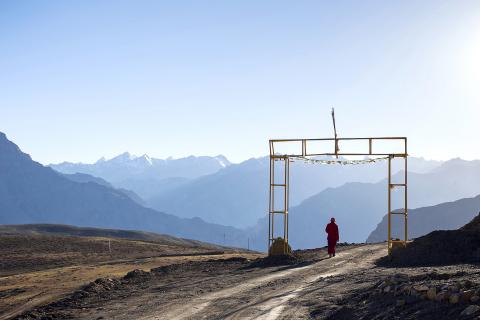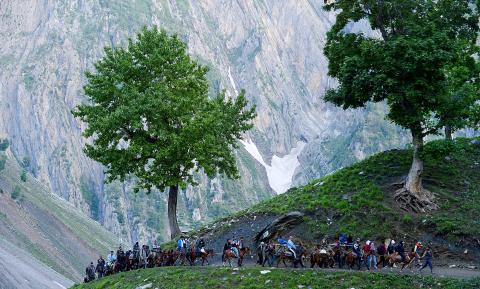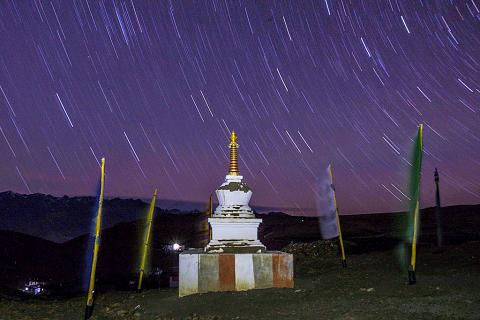At the top of the Miyar Valley in the high Himalayas, a chain of seven tiny turquoise pools nestle below the snout of a formidable glacier.
Each one looks deceptively inviting. We plunge in and our shouts, as we brave the icy water, echo off walls of rock into empty air; there is no one but our group around to hear. For miles in every direction there are only mountains; their white peaks, sheer slopes and pockets of high hidden valleys are filled with wild flowers for just a few months of the year, mainly June and July, when their cape of snow melts away.
Most stunning are the fragile, brilliant blue Himalayan poppies, which inspire such devotion that there is a book, Blue Heaven, dedicated to them. Some are scattered among the rocks around the pools, above the grassy meadows which feel like our own private heaven. We rest here for a day to acclimatize before heading up on to and across the glacier, playing cricket at nearly 4,000m and reading in the sunshine. Mobile phone reception had petered out beyond the last village several days earlier, so even the most anxious have gradually settled into the rhythm of unconnected days, blissfully cut off from the rest of the world.

Photo: AFP
In the week after leaving the highest village in the long Miyar Valley, we see yaks and horses roaming half-wild, and marshy lakes filled with migrating birds, a joyful patchwork of red, pink, white, yellow and blue flowers, but fewer than a dozen other people. Most are nomad shepherds who spend the summer guiding their flocks to seasonal grazing grounds along ancient paths invisible to the uninitiated, dotted with tiny stone huts that provide shelter from the elements.
BUDDHIST UTOPIA
In 1933 the British author James Hilton coined the term Shangri-La to describe a secluded Buddhist mountain utopia. The word, and the dream it represented, escaped the pages of his novel Lost Horizon and became embedded in popular culture, idealized, constantly reinterpreted and appropriated for the name of everything from a chain of luxury hotels to the most offbeat area of the Glastonbury festival. Few of them bear much resemblance to the rural idyll Hilton describes. In the Miyar Valley though, Hilton might have recognized something like his forgotten, isolated paradise.

Photo: AFP
Police in Urgos, the last sizable village before the wilderness unfurls towards the highest peaks, must record every visitor to the valley.
There are so few that years of names and personal details are stored in a single register, each painstakingly written out longhand by the officer, rarely more than 200 each season.
A simple visitor center can help arrange “homestays” in the village, or for you to pitch tents for a first night of camping on the village cricket pitch, beside a fast-rushing stream and overlooking the roofs of a historic Buddhist temple. If you can find the custodian, he will unlock it (in return for a small donation to the temple offering boxes), so you can pad around barefoot to inspect a storehouse of sacred scrolls and gilded statues that gleam in the light of yak butter lamps. On the ridge of a hillside above, prayer flags flutter along the path to another shrine.

Photo: AFP
TREKKING
We set off on our trek early the next morning through pine forests with a soft, fragrant carpet of cones and fallen pine needles, tracing field boundaries beside the raging torrent of the Miyar River and its tributaries. There were some bridges, but twice we crossed the old way, in iron baskets suspended from a wire, hauled back and forth by fellow travelers. They sway from wind and movement as you inch over freezing water, stirring up fear and exhilaration like a good rollercoaster.
By that evening we had left civilization behind, setting up our first campsite on the edge of the wilderness. We were not roughing it. It might not be “glamping” as recognized by anyone who likes to commune with nature accessorized with fresh sheets and deep baths, but to me it seemed as close as you could get deep in a pristine Himalayan valley at 3,000m.
A talented, inventive cook conjured up hot breakfasts, feasts every evening — including a birthday cake somehow cooked on a camping stove — and a spread for daily picnic lunches. Hot tea brought to each tent was the daily alarm clock, and we often arrived at the evening’s campsite to find tents pitched, freshly cooked snacks and bowls of warm water for washing.
There was extra padding for sleeping mats, a lantern for evenings playing cards or planning the next day’s route, and even a toilet tent. While the beauty and solitude felt like the ultimate luxury, traveling with a local, family-run trek company meant that the trip was very reasonable, and with nowhere to spend money in the mountains, there was no chance of going over budget. After our day by the seven pools, we were meant to continue on over a pass of about 5,100m, and down through another flower-filled valley, but when one member of our group started developing severe altitude sickness we decided to return instead.
There was an option for some guides and trekkers to continue, but we preferred to stay together. It felt like a small sacrifice, the vistas on our return looking different but equally stunning, Urgos and its temple still charming.
ACCESSIBLE MOUNTAIN TREK
For visitors who want to see the high Himalayas, but might be wary of their steepest passes, the Miyar Valley makes a great trip. It’s relatively accessible for novice trekkers because it is unusually long and relatively flat (one of our group was 73 years old), but can also be the start of a much longer, more demanding trek. If you continue up the glacier, you reach the Kang-La pass, which leads down to the fabled Tibetan kingdom of Zanskar.
Or you can cross the glacier at its snout, head over another high pass in the shadow of Menthosa, the nearly 6,500m peak that was first climbed only in 1970. Yet despite the history, the mountains, the tranquility, the culture and the ease of access to higher meadows, the Miyar Valley is almost as unvisited as the original, mythical Shangri-La. This paradise for visitors — locals are ambivalent about their isolation, not least because almost all the young people leave to look for work in towns — will not last.
VISIT PARADISE NOW
The reason for the tranquility, and the price visitors must pay to escape there, is a relatively long journey by air, train or road to the valley and back. From the Indian capital Delhi you fly to Manali, once a sleepy hill town, now the epicentre of the local trekking and tourism industry. A day of driving follows, up and over the 4,000m Rohtang pass, a hair-raising journey of bends and ice even in high summer. For centuries, perhaps millennia, it has been a vital transport artery, linking the Lahaul valley to the world beyond.
That role is coming to an end now though, after the Indian government drilled through the mountains to build the all-weather Rohtang tunnel, that will tie Lahaul more closely to the rest of the country and, as a side-effect, open up tourism in Urgos.
It will still be relatively remote, but the tunnel — due to open next year — will make it feasible to get from Delhi to the edge of the Miyar within a (very long) day. More tourists will certainly follow; try to visit before they do.

June 23 to June 29 After capturing the walled city of Hsinchu on June 22, 1895, the Japanese hoped to quickly push south and seize control of Taiwan’s entire west coast — but their advance was stalled for more than a month. Not only did local Hakka fighters continue to cause them headaches, resistance forces even attempted to retake the city three times. “We had planned to occupy Anping (Tainan) and Takao (Kaohsiung) as soon as possible, but ever since we took Hsinchu, nearby bandits proclaiming to be ‘righteous people’ (義民) have been destroying train tracks and electrical cables, and gathering in villages

Dr. Y. Tony Yang, Associate Dean of Health Policy and Population Science at George Washington University, argued last week in a piece for the Taipei Times about former president Ma Ying-jeou (馬英九) leading a student delegation to the People’s Republic of China (PRC) that, “The real question is not whether Ma’s visit helps or hurts Taiwan — it is why Taiwan lacks a sophisticated, multi-track approach to one of the most complex geopolitical relationships in the world” (“Ma’s Visit, DPP’s Blind Spot,” June 18, page 8). Yang contends that the Democratic Progressive Party (DPP) has a blind spot: “By treating any

Swooping low over the banks of a Nile River tributary, an aid flight run by retired American military officers released a stream of food-stuffed sacks over a town emptied by fighting in South Sudan, a country wracked by conflict. Last week’s air drop was the latest in a controversial development — private contracting firms led by former US intelligence officers and military veterans delivering aid to some of the world’s deadliest conflict zones, in operations organized with governments that are combatants in the conflicts. The moves are roiling the global aid community, which warns of a more militarized, politicized and profit-seeking trend

This year will go down in the history books. Taiwan faces enormous turmoil and uncertainty in the coming months. Which political parties are in a good position to handle big changes? All of the main parties are beset with challenges. Taking stock, this column examined the Taiwan People’s Party (TPP) (“Huang Kuo-chang’s choking the life out of the TPP,” May 28, page 12), the Democratic Progressive Party (DPP) (“Challenges amid choppy waters for the DPP,” June 14, page 12) and the Chinese Nationalist Party (KMT) (“KMT struggles to seize opportunities as ‘interesting times’ loom,” June 20, page 11). Times like these can